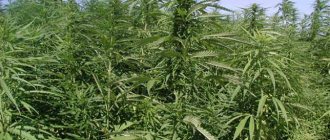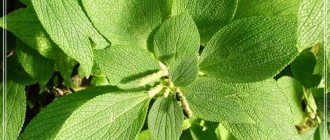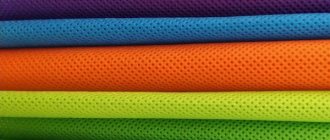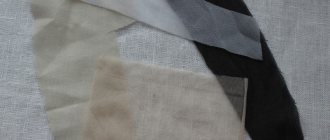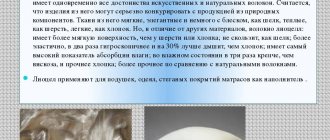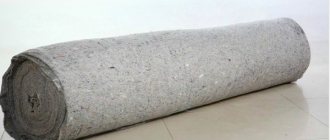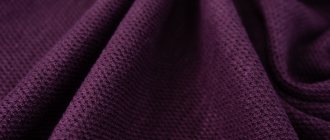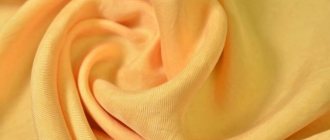Features of nettle fabric, as it is called
Nettle fabric is often called "ramie" after the type of plant from which it is made. But other varieties of crops are often used, thanks to which they obtain durable and beneficial fabric for the body. Read about the properties and use of stripe satin fabric here.
The production of this material is quite expensive. Therefore, it is quite expensive, but it has unique properties that other types of textiles do not have.
Composition and properties
When the phrase “nettle fabric” is uttered, many people associate it with a burning sensation. In fact, this matter does not have such properties, since unpleasant feelings can only be provoked by needles on the surface of the leaves and stem of the crop. And to create ramie, only the fibrous part inside the stem is used. This material will tell you what satin jacquard fabric is made from.
After the resulting parts are processed, they acquire a pure white color and a glossy surface. Due to this, the fabrics obtained from such threads resemble real silk (twill). But such product options are quite expensive due to the labor-intensive process of obtaining high-quality fibers.
Nettle textiles gained popularity in the 1980s, when it became fashionable to use environmentally friendly materials for clothing production.
Advantages and disadvantages
Differs in the following parameters:
- increased strength, unlike Lyon fabric, which increases if the material gets wet;
- absorbs dirt and moisture well;
- has antibacterial properties;
- dries quickly;
- resistant to rotting and exposure to insects and microorganisms;
- immune to alkaline and chemical influences;
- does not shrink;
- temperature resistant;
- not electrified;
- Easy to paint and retains color.
Clothes made from nettle have an attractive, glossy shine.
But like other natural fibers, nettle also has certain disadvantages:
- creasing;
- low abrasion resistance;
- rigidity;
- low elasticity;
- high cost;
- fragility.
The price is now quite expensive due to the difficulties of producing such materials. Processing is carried out primarily by hand. Therefore, finding textiles from this plant today is quite difficult. Read about furniture fabrics from Arben in this article.
Natural fiber production and manufacturing
Production begins with the collection of the plant itself. To do this, the stems are cut off almost at the very root during the flowering period. This is done manually so as not to damage the core, which is removed after cutting. The received materials then go through the following stages:
- Drying raw materials.
- Removal of resins using chemical or biological methods.
- Next, the fibers are crushed, scuffed and carded.
- After the finest fibers are obtained, the creation of threads begins, and from them - fabric.
When processing the internal parts of the stem, a silky and thin fiber is obtained, 120-500 mm long.
To this day, nettle fabrics are made by hand from start to finish by many supporters of environmentally friendly production.
Ramie plant from which yarn is obtained
The Ramie plant grows mainly in Japan and China, as well as in the Asian mainland in general. But in the Slavic expanses you can only find a dioecious culture, which produces a mostly dense and slightly rough fabric.
Ramie is a branched perennial plant whose lifespan can reach 20 years. The height of the stems can reach two meters, and cutting is done up to six times a year. The main supplier of raw materials and products made from them is China. India, the Philippines, Indonesia, and South America produce slightly less. This link will tell you about Blakit's bed linen.
In Korea they even hold a festival dedicated to Rami. It brings together the world's leading designers, and also hosts a fair with products from this culture.
Production
To obtain high-quality nettle fabric, 100% compliance with fiber processing technology is necessary. Proper harvesting is also important.
It begins when the stems change color from green to brown. If you collect the raw material earlier, the threads obtained from it will be fragile. And if later, it will be difficult to separate the fibers from the stem.
Let's look at how clothes are made from nettles. Manufacturing is divided into several stages:
- collection of raw materials;
- separation of fibers and their drying;
- resin removal;
- obtaining yarn and fabric from it.
The production of clothing from nettle is labor-intensive in the initial stages, since the fibers for future threads are obtained manually. Afterwards the raw materials must be dried. This stage takes from three days to a week, it all depends on weather conditions.
Afterwards, the so-called resin, which has increased stickiness and pungency, is removed from the fibers. Each manufacturer has its own method of purifying raw materials. As a rule, it is not disclosed. After all the treatments, thin, light fibers 120 millimeters long are obtained from nettle. They are used to weave fabric of different densities. Typically a simple plain weave is used.
Scope of application: what is sewn from fabric
Used for sewing and manufacturing:
- household products - bags, ropes, etc.;
- dresses;
- blouses, shirts;
- trousers, skirts;
- jackets, blazers;
- towels, bedding.
Since the wear resistance of ramie fibers is low and fragility is high, the raw material is mainly used in fabrics of mixed composition to improve the properties of products. Read about the composition of capitonium fabric here.
Interestingly, nettle fibers are also used in the creation of filters, cleaning devices, ropes, and paper. Some countries use the material to create banknotes.
Application area
Ramie is used to make clothes and home textiles. Nettle fiber is used as a filling for mattresses and pillows.
Women's summer clothes made from nettle are made from thin fabric. Lightweight material with a delicate shine allows you to create stylish and comfortable dresses, T-shirts, blouses, tops, and skirts. Trousers and jackets are made from thicker fabric. Men's clothing is also made from ramie - shirts, T-shirts, summer suits.
Bed linen sets, kitchen and bath towels, and tablecloths are produced from nettle fabric. They do not lose their color brightness and natural shine for a long time.
Nettle fiber has found application in the production of mattresses and pillows. Ramie filling is believed to have a beneficial effect on the body. A mattress and pillow made from nettle will give you healthy dreams: they will relieve insomnia and strengthen the nervous system.
Recommendations for caring for the material
Nettle fabrics are easily tolerated:
- dry dry cleaning;
- machine washable;
- ironing;
- whitening;
- digestion and other types of exposure.
So, due to the increased fragility of the fibers, things from this plant should be dried and stored in a horizontal position, avoiding folds and creases.
But like other options for natural fabrics - such as bamboo fiber and hemp fabric, nettle also has disadvantages that you need to be aware of.
If the fabric is mixed, then when caring, you should follow the manufacturer’s recommendations indicated on the label.
Video
Watch the video to see how nettle fabric is made:
Advantages
Clothing made from nettle compares favorably with items made from other natural materials. Its advantages:
- high hygroscopicity, the material perfectly removes sweat from the body;
- Excellent thermoregulation and breathability. The body suffocates in the heat, and in cool weather the heat is retained at its surface;
- strength and wear resistance with proper care, things made from nettle last a long time without losing their attractiveness;
- spectacular appearance: thanks to the natural shine, ramie is not inferior in beauty to silk. At the same time, the gloss does not fade after washing or drying in direct sunlight.
Also, clothes made from nettle are very soft and comfortable to the body, and have a healing effect.
conclusions
So, what is worth knowing about nettle fabric:
- From the dioecious plant variety, fairly strong, but rough, tough, natal tissue is obtained.
- Elite fabrics are made from ramie.
- Due to increased fragility and abrasion, the service life of things of this type is somewhat lower than that of other materials.
- Antiseptic properties will be useful for allergy sufferers, as well as people who suffer from hyperhidrosis.
- Ramie is easy to care for, but requires certain storage conditions.
- Nettle material is quite expensive, but it is an environmentally friendly plant tissue.
- Most of this type of textile is produced in China.
Composition, types and properties
100% ramie fabric contains Chinese nettle (Boehmeria nivea) fibers. It grows in South-East Asia: China, Indonesia, India, South Korea. This is a perennial species of nettle. Its bushes reach two meters in height. And the harvest is harvested 2 to 4 times a year.
Boehmeria nivea fibers are long and strong, but require manual processing, making fabrics made from them expensive. Despite the high cost, the material is becoming more and more popular. This is due to the properties of ramie fabric made only from nettles:
- environmental cleanliness . When growing raw materials, no pesticide treatment is required and no harm is done to the environment;
- hypoallergenic . Natural nettle fiber is gentle on the skin and does not irritate it;
- antibactericidal effect . Fungi and bacteria do not multiply on the surface of the fabric. When in contact with the body, clothing has a therapeutic effect: it prevents skin diseases, reduces the unpleasant odor during sweating;
- easy dyeing and color fastness . The fabrics do not fade in the sun and do not fade after washing.
Procurement of raw materials and production of fibers from nettles
Although our project was launched back in August, we were only able to start collecting raw materials in October, when the nettles finally began to shed their leaves, dry out and turn brown.
And by this time we had managed to study in sufficient detail on the Internet how to process plant stems to extract fibers. In online videos, we saw two main ways to obtain fiber: completely manual (removing fibers from the stem) and traditional - using devices (kneading, carding, etc.). It was decided to test both methods of work.
Instruction card “Making a shuttle”
| No. | Sequence of work | Tools and accessories |
| 1 | We will need: plywood | Ruler Corner Pencil |
| 2 | On 3 mm plywood, mark the lines according to the drawing and cut out with an electric jigsaw and sand the part. | Pencil Ruler Corner Electric jigsaw |
We are sure that the hammer and loom with a shuttle will serve as an excellent visual aid for technology lessons.
Instruction card “Primary processing of nettle fibers”
| Sequence of work | 1 method “Manual processing” | Method 2 “Traditional” | |
| 2. | Cleaning the stem from leaves | ||
| 3. | Flattening nettle stems (it’s impossible to do without gloves and scarves! Everything is prickly and there’s a lot of dust) | ||
| 4. | Releasing fibers from the stem | We carefully split and break the stem without damaging the fibers | Slowly knead a bunch of nettles using a crusher. The main thing is not to damage the fibers |
| 5. | Cleaning fiber debris | Using smooth movements, separate the fibers from the trust | Gently grind and shake the mashed twigs to free them from debris |
| 6. | Combing out fibers | Using a mild knife, remove the wax coating from the fibers. Very painstaking work! | Using gentle, smooth movements, comb out the tow. There's still a lot of trash |
Our work was not easy. The fibers are very delicate and do not have the promised strength. A lot of time was spent on mechanical cleaning of debris using method 2. Of course, method 1 is cleaner, but it's too slow!
Instruction card “Making a grinder”
| No. | Sequence of work | Tools and accessories |
| 1 | We will need: · plywood from 5 mm to 10 mm timber | ruler corner pencil |
| 2 | We make markings according to the drawing on plywood and timber | ruler corner pencil |
| 3 | We cut out according to the markings with a jigsaw, larger parts on a circular saw or with a hacksaw | Electric jigsaw Circular saw (hacksaw) |
| 4 | We sand all parts with sandpaper or a grinding machine. | Sandpaper Sander |
| 5 | We mark and drill holes according to the drawing. To prevent the plywood from splitting open. Sand the chips around the hole. | Drill Drill Sandpaper |
| 6 | We secure the bottom to the bars with wood screws. | Screwdriver |
| 7 | We place the middle part between the other two and insert a threaded pin along the edge and tighten the nuts. | Spanner |
